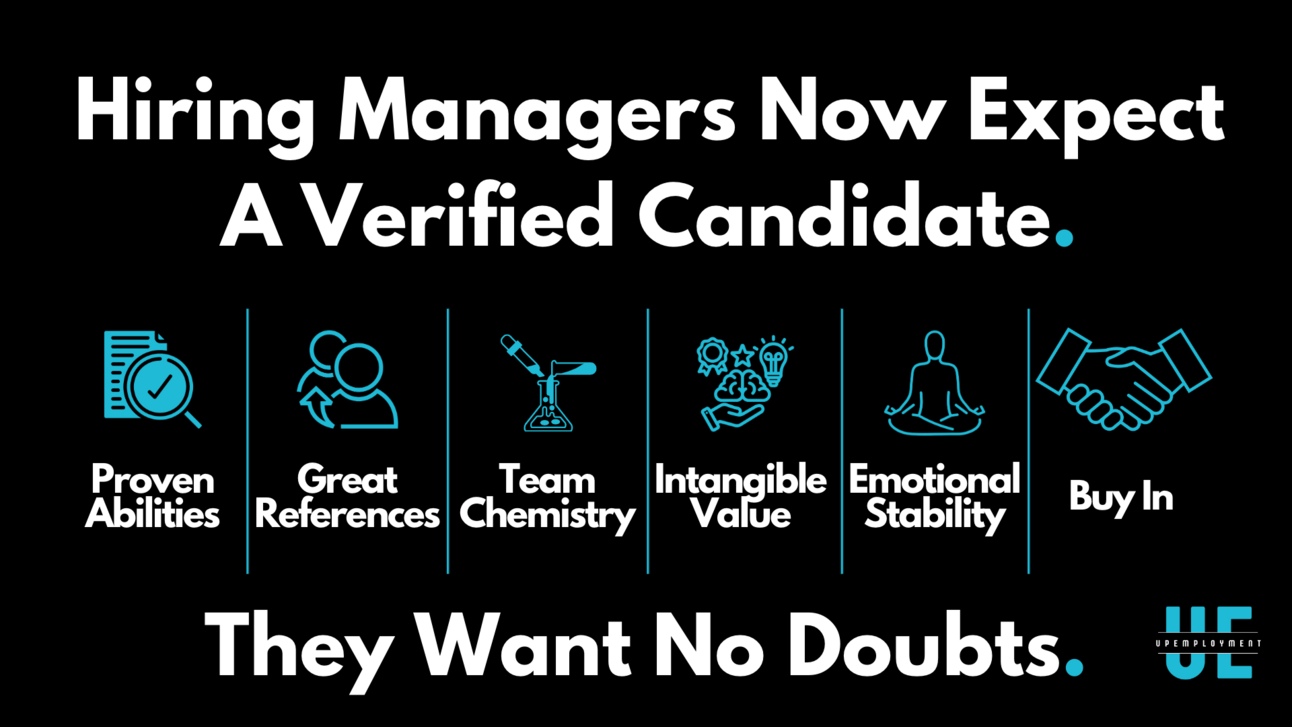- Early
- Posts
- What's Your Real Job As A Job Hunter? - Part 1
What's Your Real Job As A Job Hunter? - Part 1
Here's a clue... it's not finding a job.

(Read time 6 min 55 sec)
If you’re job hunting, you may have heard this from your mom, dad, or grandma.
Hell, you may have even said it yourself.
It’s well-meaning but terrible advice on many levels.
Your full time job is finding a job.
Why is this bad advice?
Shouldn’t your main focus be to land another job?
It’s true that the outcome you’re looking for is your butt cheeks to be placed squarely in the seat at a new company, with an exciting role, career acceleration, and more money in your pocket.
But focusing solely on finding the job is not how you should think about your job hunt.
This advice made sense in the ’90s or earlier, when finding an online job board, looking in the classified section, finding a job, sending in a resume, and waiting to be contacted was effective.
But that’s not how things work anymore.
With the creation of the easy apply button in 2013, the rise of remote work, and the increased usage of AI tools to level the playing field for basic skills, those days of being competitive because you found the job are long gone.
Today, you’ll need to do much more than simply finding a job.
It all starts with a change in mental focus.
The problem with having your sole focus be finding the job is that it leaves out everything else that leads to landing world-class roles.
Finding the job is a very small part of the process.
In fact, if you do everything right, in many cases, you don’t even need to find the job.
The job finds you.
Your New Job is Eliminating Hiring Manager Doubt
So let’s start over.
Erase that “your job is to find a job” nonsense from your mind and start with a clean slate.
What would make finding the job you want an inevitability?
Not an “I hope I get it,” but an “it’s only a matter of time until I get it.”
Let’s start with the end in mind.
Who is going to be the person that makes the final decision about whether or not you’re hired?
This isn’t a trick question.
It’s the hiring manager.
So think about what would need to be true for the hiring manager to look at you and, without ever speaking with you, say, “That’s the person we want!”
The answer…
Your job is to remove all doubt from the hiring manager's mind.
That’s it.
If I were creating an electric vehicle company and I could choose anyone in the world to be on my team, who would be the first person I would select?
Elon Musk.
Why? Because I have no doubts that he could run an electric vehicle company.
It’s clear to me who he is, what he has done, and the results he can drive.
Consider every potential doubt a hiring manager would have about placing you in the role you want at the company you want to work for.
Then do everything possible to eliminate those doubts before they arise.
Don’t wait for someone to ask you to prove who you are and what you can do.
Go play offense.
Put it right in their face.
The 6 Areas of Candidate Verification

We now live in a verification economy.
Computer programs verify that you’re human.
Banks verify it’s you accessing your account.
You present your ID to get into a bar because of… verification.
No one wants to look stupid, particularly when hiring when the results can be fatal to a company.
So as soon as the hiring manager decides they need to hire for a position, they immediately start looking for traits that would make them feel comfortable and confident in the person they add to their team.
There are six major areas hiring managers think about when making these decisions.
Proven abilities
Great references
Team chemistry
Intangible value
Emotional stability
Company buy-in
Solve all six of them to put the hiring manager at ease, remove all doubt that you’re the right person for the job, attract jobs you didn’t know existed, and land the ones you want.
In this edition, I’ll share three of the six areas you can focus on to eliminate doubt.
We’ll cover the final three next week.

1) Proven Abilities
I can tell you I have a magic pinky toe that creates millions of dollars for the company where I work whenever I wiggle it.
If you hired me because I told you that, you’d be a fool because you have no proof that what I say is true.
So how is it any different when I tell you that I led the launches of Uber into the states of New York, New Jersey, and Connecticut, Uber’s e-bike product in New York City, and that I have been launching and scaling operations for startups since then?
The difference is that I can prove it:
I have articles about each of those launches on my LinkedIn profile
I have playbooks I can share about how to launch like Uber
I have pictures of me in the hotel conference rooms onboarding drivers
I can ask questions about your process that proves I know what to look for and what goes into a successful expansion or product launch
Do you tell people about your abilities in your resume and on LinkedIn?
If you do, ask yourself how you can show, not tell.
You can prove your abilities in multiple ways.
Share your subject matter expertise publicly either by creating content on social media platforms like LinkedIn or writing longer form pieces in a newsletter.
Find real problems the company is solving by asking people inside and doing your own research, then provide them with something that will solve the problem.
Show proof of events by sharing links to news articles, press releases, or social media posts about things you worked on or created yourself.
Don’t worry about giving away the answers.
You’re eliminating all doubts that you can do the job.
People pay for implementation, not information.

2) Great References
We are social animals, so it’s natural to look for social proof.
That’s why testimonials are so powerful when you’re selling a product.
People see themselves embodied in the customers speaking glowingly about a product and think, “They’re just like me. I want to feel like that. I want that result.”
Your references are the testimonials of the product of YOU, so don’t wait to share them until someone asks for them or hide them at the bottom of your LinkedIn profile.
Put them front and center like you would when launching a product.
You can show your great references in multiple ways.
Reach out to your most impressive former colleagues, mentors, and bosses and ask for a 2 to 5 min video of them describing what it was like working with you, the results you drove, and anything else they enjoyed. Post the videos in your featured section, one-liners in your About section, and links to the videos in cold outreach messages.
Have references post their written referrals in your LinkedIn references section.
Create a “Board of Advisors” slide at the end of a value deliverable or company exercise with the names, positions, and contact information of people you go to for different types of questions.
The more five-star reviews a product has on Amazon, the more likely it shows up in your shopping feed and the more likely you are to buy.
Your references are your five-star reviews.
Share those five-star reviews!

3) Team Chemistry
“Would you want to grab a beer with this person?”
While that question has fallen out of favor, its theme is as important as ever to hiring manager confidence.
Is this person going to be someone I want to spend more time with than my friends, partner, or kids?
Would I want to work with this person for the next 10 years of my life?
When the shit hits the fan, and we need to order a bunch of pizzas and work through the night to ensure everything is okay, is this a person I want by my side?
Your goal is for the recruiter and hiring manager to say, “The team loves you,” ideally before the interview process even starts.
So how do you get there?
You can create chemistry with the team before landing the role by:
Reaching out to members of the team (not just the hiring manager and recruiter) via email, LinkedIn or social DM, setting up meetings, and being curious about the problems they’re solving and things you can share to help them.
Writing on LinkedIn about the great work the company is doing and linking people from the team in your post.
Connecting the people at your target company with relevant people in your network and opportunities you think might be interesting.
Researching the backgrounds, work histories, interests, and projects of every person you will be interviewing with and highlighting relevant areas in your interview questions and conversation.
The average person will reach out to the hiring manager and recruiter and will have their first interaction with the team during the interview.
Your goal is to go into the interview with a team of supporters.
We’ll stop there for this week and leave the last three ways to remove hiring manager doubt until next week.
Hopefully, this introduction has shown you how powerful a change in job hunt focus can be.
Instead of solely focusing on how you can find the job you want, focus on what it would look like if the hiring manager at your target company had no doubts that you were the right person for the job.
Work backward from there and you may not need to search for a job because the hiring managers will be coming after you.
📈109 Hiring Startup Companies

We’re 17 days into June, and 80 companies have raised over $2.3 billion, and 40 are actively hiring people like YOU!
There you have it...
The first three areas you can focus on to eliminate all doubt in the mind of hiring managers at your target companies to land more offers
80 companies that have already raised $2.3 billion this month
An additional 157 companies that raised $5.6 billion last month
Which of them have open positions, and what they’re hiring for
I’ll be back next week to share the final three areas you should focus on to eliminate doubt in the minds of hiring managers.
But until then… let’s become career champions together 🏆
Cheers,
Kyle
P.S. Whenever you’re ready, there are 2 ways I can help you:
#1: Free Job Hunt Strategy Call: Request a free job hunt strategy call with me to get closer to landing your next career-accelerating tech role. Schedule a free call today!
#2: Follow me on LinkedIn for more job hunt systems, productivity tools, and networking templates.
Share UpEmployment
Don’t job hunt alone! Share this newsletter with anyone you know that is currently looking for that next career-accelerating opportunity so you can win together.
Forward them this email or just copy and paste this link: https://upemployment.beehiiv.com/subscribe
Reply